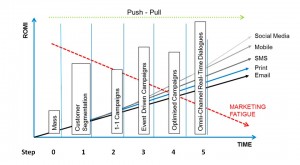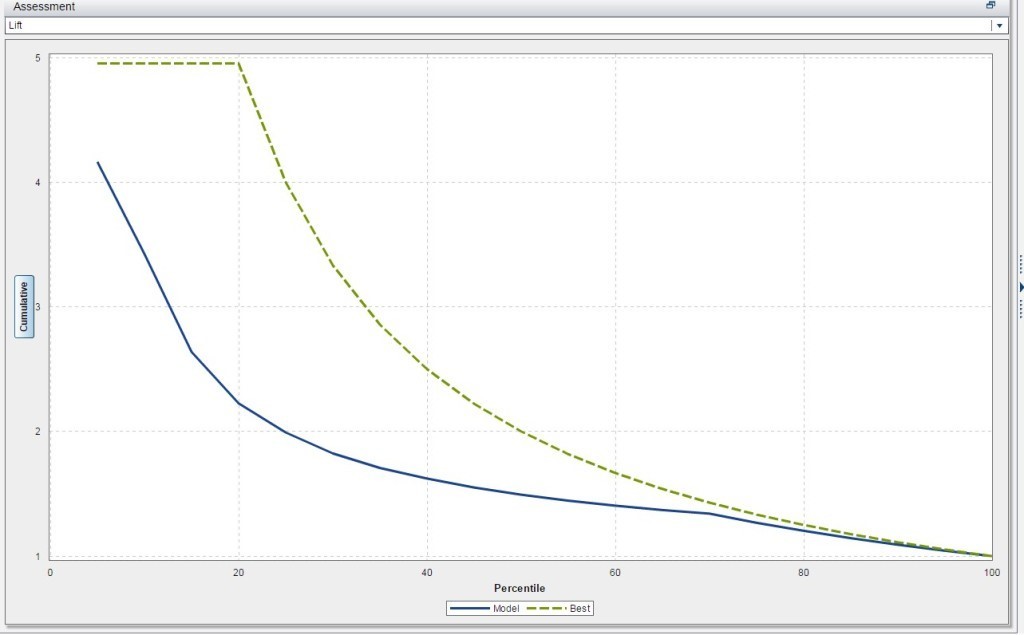As a customer intelligence adviser, my work exposes me to a wide range of organizations with various marketing challenges and available resources.

Over time, some common themes have emerged, one of which is omni-channel marketing as a business imperative due to the explosion of channels and the evolution of customer behaviour.
The way organizations have approached omni-channel marketing seems to fall into a five-step pattern, so that inspired me to write this five-part blog series titled, Five steps to omni-channel marketing.
In the first post in this series (Five steps to omni-channel marketing-step one) I explained how you can move as an organization from mass marketing to segmented marketing. In this post I will explain how you can take the second step to move from segmented marketing to one-to-one marketing. Let's start by examining just what one-to-one marketing is.
Step 2: From segmented marketing to one-to-one marketing
One-to-one marketing is a strategy emphasizing personalized interactions with customers. It was first introduced in the book “The One to One Future: Building Relationships One Customer at a Time,” by Don Peppers and Martha Rogers (1993). By delivering highly personalized and relevant messages we expect to have more loyal customers and better marketing ROI. The reason why it comes after segmentation is because one-to-one marketing is sometimes referred to as the “segment of one.” And as it often is, one-to-one marketing is easier to say than it is to do.
A one to one campaign starts with the fact that you need to have insights for a specific customer. For example, what is the chance that customer X will buy product A.
To get this insight you could use uplift modeling techniques to score which customers have a high probability to accept a certain product offer or for example are going to churn. It’s my belief as a marketer that you don’t have to understand the statistical models running behind this scoring process, but rather you need to understand the output as key information for the campaigns you will be running. That’s why I included an example of an Uplift chart which is one of the result you get when running a propensity model.
 The above graph gives an overview of the lift chart. The idea is that you stop targeting the entire segment, and instead select people that have a score above a certain threshold. The Y axis gives an overview of the lift. The X axis gives an overview of the percentage of the database you’re targeting. The most interesting line is the blue line which shows the tradeoff between the lift and the percentage of the people you’re targeting. If we would target the first 20% of the database this would result in a lift of 2.2. This means that the response on the email will be 2.2 times higher in comparison to targeting the entire database. Doing that also reduces marketing fatigue because the other 80 % of your customers won’t be annoyed with your offer that’s less relevant to them.
The above graph gives an overview of the lift chart. The idea is that you stop targeting the entire segment, and instead select people that have a score above a certain threshold. The Y axis gives an overview of the lift. The X axis gives an overview of the percentage of the database you’re targeting. The most interesting line is the blue line which shows the tradeoff between the lift and the percentage of the people you’re targeting. If we would target the first 20% of the database this would result in a lift of 2.2. This means that the response on the email will be 2.2 times higher in comparison to targeting the entire database. Doing that also reduces marketing fatigue because the other 80 % of your customers won’t be annoyed with your offer that’s less relevant to them.
Now that the model is developed we have two options to integrate it into a campaign. One option is to run the model in a batch mode which means that you automatically score the customer overnight and make that score available in you marketing automation system or you can integrate the model in Customer intelligence Studio.
 In the display above you can see an example of both approaches. I have first selected the customers that I have available. ThenI merge them and do an exclusion of the people that I can’t target, which is an available link cell with our standard exclusion. Then I select the 20 % of the customers with the highest propensity score as this has a lift of 2.2 coming from the lift chart, which I find a good project response rate.
In the display above you can see an example of both approaches. I have first selected the customers that I have available. ThenI merge them and do an exclusion of the people that I can’t target, which is an available link cell with our standard exclusion. Then I select the 20 % of the customers with the highest propensity score as this has a lift of 2.2 coming from the lift chart, which I find a good project response rate.
Not only do I need to know which customers are most likely to leave, but I also need to figure out the next best offer for each of those customers. This is when we come to almost a one-to-one, with each individual having their own personal offer.
In the last step I use an A-B test to check which visual element performs the best for my win back campaign. The display above may help you visualize the process if it were to be attempted without segmentation. In that case, you could send out a different context message to every segment.
Hopefully this simplified example helps illustrate how you can attempt one to one marketing. And the more complex your business, the more it will help to have a marketing solution that can scale to the size your business has the potential to grow to. One example that can help you envision the possible is the story of how office superstore Staples is boosting profits and loyalty through better marketing. Interested in learning more? Start by looking at our page for insights on customer analytics.
The next steps will be to examine how to progress from one-to-one marketing to event-driven marketing, optimized marketing and then full-blown omni-channel marketing. Stay tuned!


1 Comment
Pingback: Five steps to omni-channel marketing - Step 3